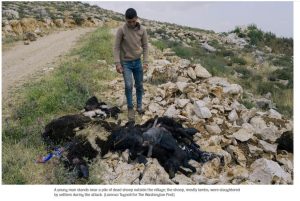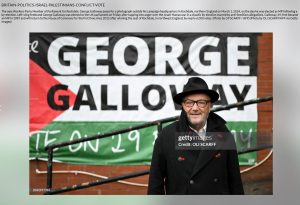Total War: Total warfare is a war … against any and all ~ilana
To refuse to bear witness to the prosecution of Total Warfare against Gazans—also the defining event of 2023 and the decade, twinned with COVID—is to be inhuman, insane, incoherent. To the Greek philosophers, to be mired in such contradiction was to be less than human, less than coherent, less than sane ~ilana
For one thing, he who offends against innocents is responsible for his offenses; not a third party. For another, whether it is committed by decree of the one or by the will of the many; by actors within or without The State; by the designated ‘good guys’ or by the ‘bad guys’—murder of innocents is always murder. Murder by ‘democratic’ approval is also still murder, however many approve of it. At the same time, mass murder is never ‘unintentional’ when you know it is inevitable and incidental to your ‘mission’ ~ilana
INTRODUCTION TO THIS POST (Begun Oct 7):
Inarguably, the case against Israel’s murder spree in Gaza is ethically quite simple. (“Hermetically Sealed Indictment Of The Jewish Taliban’s Mass Murder And Ethnic Cleansing In Gaza,” January 4, 2024.) It is NOT within the realm of opinion. It is immutable, eternal truth. Right and wrong are universal, not relative. There are no tribal privilege clauses. Like gentiles, Jews are prohibited from mass murder. The Sixth Commandment is not opinion. Neither is it optional. “Thou shalt not murder” is called a commandment for a reason. Saint Augustine’s Just War Theory, while imperfect, is closer to truth than opinion. Natural law going back to the ancients and derived from deductive reason and the nature of man: not opinion. What Israel is visiting on Gazans and their little enclave is irreparable, orgiastic mass murder and ethnic cleansing. A “blitzkrieg, by any other name,” against a civilian populations, which is being bombed, buried—alive and dead—evicted for life. There is no debate about the veracity of this statement.
 (Credit Al Jazeera, via screen pic capture)
(Credit Al Jazeera, via screen pic capture)
UPDATE (8/29/024): Israel: What Moral Rot Looks Like: As Israel’s IDF death squads—Einsatzgruppen—murder, maim, starve and destroy all civilian life in Gaza, and increasingly the West Bank—where land and pitiful possessions are being stolen daily with impunity by armed settlers—the IDF’s auxiliaries, says Mouin Rabbani—Israelis party on. The picture of decadence:
(7/23/024): Palestinian beauty BELLA HADID has held strong against the genocidal forces of evil. Boycot Adidas, which caved to the Zionist lobby, which is responsible for throttling, banning, libeling and maligning all protest, written or enacted, against Israel’s genocide of Gazans.
ALSO: BUSTED. The International Court of Justice (ICJ) Issues Momentous Advisory Ruling AGAINST Israel’s Occupation, including how these rulings must be operationalized, namely, the
“Legal Consequences arising from the Policies and Practices of Israel in the Occupied Palestinian Territory, including East Jerusalem.”
Summary of the Advisory Opinion of 19 July 2024
Israel, moreover, is bound by this decision by virtue of being “party to several legal instruments containing human rights obligations, including the International Convention on the Elimination of All Forms of Racial Discrimination of 21 December 1965 (CERD), the International Covenant on Economic, Social and Cultural Rights of 16 December 1966 (the “ICESCR”) and the International Covenant on Civil and Political Rights of 19 December 1966 (the “ICCPR”).” (READ Summary of the Advisory Opinion of 19 July 2024)
Some analysis is at Al Jazeera. I found Lamis Deek’s interview with George Galloway most excellent and compelling.
7/11/024: MASS HANNIBAL Confirmed: Scroll down in this lengthy war-log, which I have kept going since October, 2023, to November 11, 023, when I quoted Col. Nof Erez “describing the Israeli army’s response to Oct. 7 as ‘MASS HANNIBAL.” Yasmin Porat, I wrote below, “bore witness to the same.” I cited her Hebrew interview with Aryeh Golan.
Ha’aretz has finally done its journalistic due diligence, on how Israelis military both issue and obey orders to kills their own, although the israeli daily hums and hedges a lot:
“Documents and testimonies obtained by Haaretz reveal the Hannibal operational order, which directs the use of force to prevent soldiers being taken into captivity, was employed at three army facilities infiltrated by Hamas, potentially endangering civilians as well.”
Mondoweiss: The “Haaretz report was significant in the number of military sources it interviewed who confirmed that there were direct orders to implement the Directive,” which is “an Israeli policy that instructs the military to open fire on its own soldiers to prevent them from being taken captive.”
Essentially, “Israeli Officials OK’d Using Hannibal Directive to Turn Border Area on Oct. 7 into ‘Extermination Zone.’” (Democracy Now!)
(6/25/024): The faction that is imperiling Rep. Jamaal Bowman’s career now has put an end to most of our careers over 23 years:
As below, but add the “Israel lobby, Republican and Democrat.”
“The Democratic establishment and Israel lobby are seeking to destroy the political career of Rep. Jamaal Bowman because he dared to criticize the Israeli genocide of Palestinians in Gaza. And many liberals are joining right in.” (Mondoweiss)
“The Democratic establishment and Israel lobby are seeking to destroy the political career of Rep. Jamaal Bowman because he dared to criticize the Israeli genocide of Palestinians in Gaza. And many liberals are joining right in.” (Mondoweiss)
(6/18/024): The phenomenon of Israeli right-wing activists physically stopping food delivery to the starving I dealt with in “Defending Gaza (Part I): Natural-Law Principles Vs. National-Interest Statism” (06/09/2024) & “The Jewish State Is Genocidal, But Is Israeli Society Sick, Too?”
These execrable entities have now been joined by another notable group: “Kibbutzniks who are also blocking humanitarian aid to Gaza with their [off-putting] bodies.”

Good news: Egyptian soldiers are raring to go. They say “their country has failed Gaza.” Conscripts at the Sinai-Gaza border decry the Sisi government’s silence on the killing of own soldiers and inaction towards Israeli atrocities.”
(6/10/024): Palestinians Had Always Poo-pooed the Pier. They Know America.
Videos circulating on social media showed the helicopters that were used in the operation to evacuate the Israeli captives taking off from the vicinity of the U.S. pier that was built off the coast of Gaza in order to deliver “much-needed humanitarian aid” to Gaza. The $230m pier, which was completed last month, has drawn significant criticism from rights groups and activists who say the pier is an ineffective way to deliver aid.
6/9/024: “Today’s rescue operation,” tweets Itay Epshtain, senior humanitarian law and policy consultant, “raises concerns with numerous civilians injured and killed, and – according to unconfirmed media reports – perfidious use of humanitarian relief vehicles launched from the pop-up port.” Earlier in their genocide, the Israeli commando, if you recall, had committed a massacre in the Ibn Sina hospital in Jenin, Gaza, dressed in scrubs. There are as yet unconfirmed reports that the special forces that murdered over 50 Palestinians for each of the four hostages rescued had entered the camp disguised as a convoy of displaced persons.
(6/8/2024): A US hostage rescue?
“An American cell in Israel supported the efforts to rescue four Israeli hostages, working with Israeli forces on the operation,” the official told CNN. Four Israeli hostages were rescued from the central Gaza Strip after what appears to have been a US assisted military operation in the area. (MEM)
The death toll from the Israeli bombing on Saturday of the Nuseirat refugee camp in central Gaza has risen to 210, the Government Media Office in the besieged Palestinian enclave said, Anadolu Agency reports. ‘Some 210 martyrs and more than 400 injured were brought to Al-Aqsa Hospital due to the brutal Israeli massacre in the Nuseirat camp,’ the office said in a statement. (MEM)
A ratio of 50 to one: Fifty Palestinians dead for each Israeli rescued.
(6/7/024): Israeli attack and kills dozens of people sheltering in UN school in Gaza: Israeli serial killers “bombed a United Nations-linked school in the Nuseirat refugee camp in central Gaza, killing at least 40 displaced Palestinians and injuring dozens more according to officials and local media.” (Al Jazeera.)
It used to be thought of as treason, a citizen of one country serving in another’s armed forces. But two “Republican US Representatives” want to reward and reinforce dual loyalties. They “have submitted a bill that would extend the same benefits provided to US military servicemembers and veterans to American citizens who choose to serve in the Israeli military.” (Ron Paul Institute)
GAZA (6/4/024): Our “friends” the Israelis bad mouth any American Administration quite openly. They make it known who is in charge: the parasite state, Israel. “Speaking in Manhattan, Israel’s Diaspora Affairs Minister urges the rejection of Biden’s ceasefire plans: “No surrender, not to American pressure, not to anything.”
Israeli air attacks and shelling have killed at least 15 people in central and southern Gaza – including children, women and policemen helping protect aid deliveries in the southern city of Rafah. Civilians killed and injured as Israel announces its ground forces have moved into the Bureij refugee camp in central Gaza’s Deir el-Balah, while fighter jets and artillery attack targets in the area.

MAY 20: Glorious. “ICC warrants against Netanyahu and Gallant may be the first of many aimed at Israeli officials.” Marvelous. Has a commonwealth of common sense finally spoken? Not quite. Whether these war criminals ever sit in the dock is questionable. More poignant is what Ali Abunimah of Electronic Intifiada surmises in “ICC warrants both historic and cynical.” “Khan has charged more Palestinians with crimes than Israelis…”:
While there will be relief that finally Israel’s shield of immunity and impunity is being punctured, Khan also charged several leaders of the Palestinian resistance movement Hamas with various crimes. Khan claims that Hamas politburo leader Ismail Haniyeh, its Gaza leader Yahya Sinwar and the chief of its military wing Muhammad Deif are responsible for crimes including extermination, murder, hostage-taking, torture and rape. The political nature of the charges against the Hamas leaders is clear from the fact that Khan has charged more Palestinians with crimes than Israelis. A cynical view might be that Khan only charged the two Israeli leaders that Washington wants to see gone, while letting countless other Israeli political and military officials off the hook – at least for now. Moreover, Khan included the charges of rape and sexual violence, giving credence to Israeli atrocity propaganda that has been thoroughly debunked, and for which Israel has presented no credible evidence.
MAY 17: THE BANALITY OF EVIL. Naveh Dromi, columnist for a Ha’aretz, the most highbrow of Israel’s (center-left) dailies—Ha’aretz, which once had intellectual ballast—writes on May 16, 2024, in hideous, heavily anglicized Hebrew, that she has “a ‘teoria’” (a theory), in which Palestinians experience “a second Nakba.” Israelis are such Jewish supremacists that such statements pervade and percolate across their society, civil and state.
May 16: LET US NOT FORGET THE WEST BANK. A combined effort among West Bank settlers and IDF and security force soldiers is responsible for pogroms in which upwards of 400 West-Bank Palestinians have perished since October 7. The soldier-supported West Bank settlers have murdered more than nine Palestinians in the territory in that time. Reports Human Rights Watch:
Between October 7, 2023, and March 18, 2024, Israeli forces conducted a monthly average of 640 search-and-arrest and other operations in the West Bank, nearly double the 340 such operations during the first nine months of 2023, according to OCHA. These operations resulted in the killing of 304 Palestinians, out of a total of 409 killed by Israeli forces during this period.
Adjacent, in the Negev, Bedouin homes are demolished, hundreds are evicted, their land is grabbed. Eviction or demolition: Fear of the same is part of Palestinian life in the West Bank and beyond. There, Palestinian farmers live in daily fear for their lives and the lives of family and livestock. The latter are regularly slaughtered with biblical cruelty (PETA? Proud members and donors would like to hear PETA say something about animals and live stock slaughtered in the West Bank.) “Homes burned, animals killed: Palestinians describe Israeli settler rampage.”
May 12: The Israel First mob embodies ugly. Medea Benjamin, tiny, diminutive, long-time anti-war activist, is quiet, rational, polite. She galvanizes reason. The feral women who accost here are anything but. To say that they lack breeding is an understatement. Watch. Listen. They froth, they fulminate, they gesticulate wildly, and they wish upon her the unutterable: that she be raped, cut open. The one is an Israeli (terrorizing Medea, an American). And STUPID. You can’t quantify or fix this kind of stupid. Watch. Listen
MAY 6: WATCH. Note how unimpressive are ALL these Jewish supremacists: Their criminal minds shared willingly, in excitable, ugly, anglicized Pidgin Hebrew. Ever so base. Atavistic. Not one of the participants on Channel 12’s “Ofira & Levinson” talk show, appears remotely averse to genocide of Palestinians. Seven months into it, Israel’s mass murder of innocents does not appear to cross their minds, such as these are. Israeli sense of right and wrong—and I generalize based on extensive and ongoing polling—is utilitarian, primitive, lower-order tribalism.
Shimon Boker, vice chairman of the World Likud: “I think we should’ve gone into Rafah yesterday already… There are no uninvolved (civilians) there. You have to go in and kill and kill and kill… We have to kill them before they kill us.”
May 3, 2024: You can’t possibly be so stupid, at this stage, and after 7 months of televised, genocidal IDF action in Gaza, to believe anything the Israel First American media assert. If you are, well, here are some elementary updates: The country wide—nay, worldwide—anti-genocide campus protests, to their participants’ great credit—are peaceful. The instigators, whose violent demeanor and menacing tactics are straight out of Israel; some are alleged to be expat Israelis/IDFniks—are the genocide-supporting pro-Israel camp. Yet the New York police are arresting peaceful pro-Palestinian demonstrators and trashing their two-week-old protest encampments. Reuters has confirmed these facts, via Al Jazeera (whose report I chose for you because Reuters’ report is syntactically jumbled, I suspect, on purpose):
The attackers, carrying Israeli flags, then tried to tear down the pro-Palestinian camp, assaulting students with pepper spray, sticks, stones and metal fencing. Police stood by, failing to protect students, who re-commandeered the metal fencing thrown at them to shield themselves
APRIL 30: If you wish to retain fidelity to reality, switch off your country’s Main Stream Media all, chief of which is Fix News. Watch the “October 7” forensic expose so titled. Al Jazeera conducted an impeccable analysis of all primary sources, as a journalist must do. And it is, it seems to me, without blemish. Here, director of “The truth about October 7,” Richard Sanders, reputable, old-school British journalist, discusses his Al Jazeera film with Peter Oborne. Sanders seems quite surprised that he is no longer permitted to do old-fashioned journalism.
There was very likely sporadic rape, probably by Gaza gangs who burst through the fence. But no mass, systematic rape happened at the hands of Hamas militants, as claimed in the West. I believe two babies died in the horrific attack. None were microwaved or beheaded, as MSM keep claiming. The New York Times, however, lied, lies. In response, journalism professors have written demanding the NYT come clean and purge its lies on the topic.
Dozens of tenured journalism professors at top schools across the U.S. have raised concerns that The New York Times is risking its own credibility, as well as the credibility of journalism at large, with its inaction on an article about sexual violence on October 7 that has come under scrutiny in recent months due to its reliance on questionable — and, in some cases, debunked — evidence.
“So it’s confirmed,” tweeted Max Blumenthal. “The sister of Gal Abdush has accused NYT’s Jeffrey @gettleman, @AdamSella1 and @Anatschwartz of manipulating her family to advance the bogus narrative that she’d been raped by Hamas militants on October 7.”
The genocide in Gaza is a scandal that makes WMD in Iraq look like amateur hour.
Sources countervailing to the Fake News are The “Gray Zone,” which exposed the en masse rape lies early on, and whose coverage and commentary is excellent and smart. Al Jazeera does excellent journalism. Ditto Judge Andrew Napolitano, Middle East Eye, Democracy Now, and Novara Media. My favorite is Electronic Intifada. If you are someone who mentions the Jerusalem Post or Fox News to me—the most polite quip I can level at you is: You have not been paying attention. Differently put: clueless.
The best commentary comes, naturally, via yours truly. Scroll down this lengthy post for a list of essays, columns and podcasts. Essays and columns are here.
Meanwhile, in the West Bank, Palestinians and their homesteads and animals are subject to marauding Jewish settlers. The IDF army and Israeli police act as onlookers or aid the killer settlers.
Switch off your country’s MSM.
APRIL 12: ISRAELIS Approve. According to the Israel Democracy Institute, a polling organization, a preponderance of 55% of Jewish Israelis have a positive view of the performance of IDF Chief of Staff Herzi Halevi. Defense Minister Gallant comes in at 46%, followed by Minister Benny Gantz (37.5%).
Most remarkably, 47 percent of a sample of the Israeli Left “think that Israel should not take into consideration the suffering of Palestinian civilians in Gaza or should do so only to a small extent, while 50 percent think it should consider their plight to a fairly large or very large extent. By contrast, large majorities in the Center (71 percent) and on the Right (90 percent) say that Israel should only take into account the suffering of the Palestinian population to a small extent or should not do so at all.” (Tamar Hermann, Yaron Kaplan, Dr. Lior Yohanani, “War in Gaza Survey 13,” March 26, 2024)
APRIL 6: Gaza: What If America Were the Good Guy?: How best to move resources: It was obvious to me that aid is most efficiently delivered from a place of plenty and infrastructure, Israel, into northern Gaza. I suspect any half-decent development economist would second that. The West has only now awakened to the logic of logistics, gently nudging Israel to consider opening Beit Hanoon (Erez) crossing. But only temporarily.
Converted to a mission of mercy; the US 315th Air liftWing, for example, could make mincemeat of the Israelis, in their manifest evil.

Here is the last installment, at the Mises Institute, of my latest epic essay: “Gaza: What If America Were the Good Guy?”
https://mises.org/power-market/gaza-what-if-america-were-good-guy
THE REST, The complete essay, soon to be posted at IlanaMercer.com, is: “Israel: In Violation Of God’s Law,Natural Justice, The Laws Of War & All Customary International Humanitarian Law.”
MARCH 28: ‘Anatomy Of A Genocide’ By Francesca Albanese “Anti-Semite” is how Matthew Miller, State Department, libels Francesca Albanese for her brilliant report, “Anatomy Of a Genocide,” to the UN Human Rights Council in Geneva.

I will be out with a major essay soon. (X is cutting back my feed something fierce. Please Follow and Share. )
MARCH 22: ISIS-K-CIA? Who do you think is behind a murderous attack on a theater in Moscow? My colleague and pal David Vance has read my mind. I feel an episode of HARD TRUTH coming on. Why would ISIS-K attack a Moscow theater? And who is ISIS-K? Some low IQ Abduls the CIA has entrapped and is grooming and funding? ISIS-K-CIA?
Meanwhile, terrorist client state Israel is unleashing on Rafah with Genocide Joe’s blessing and with Made In America bombs.
MARCH 20: Drum roll for Trump’s crooked point person on foreign policy, the Middle East and much else: Jared Kushner. America’s Israel First media are in a peculiar position of covering up and finessing Jared Kushner’s nauseating remarks about ‘moving [Gazans] out and then clean[ing] it up,’ greedily intimating that “Gaza’s waterfront property could be very valuable.” That the “Middle East Initiative, a program of Harvard’s Kennedy School of Government,” entertains Jared Kushner says it all about intellectual discourse at an elite university in the US.
MARCH 16: Like the Devil she serves, Melanie Phillips thinks that the ASSERTION of IDF propaganda points, in a posh Oxbridge accept—equals a winning ARGUMENT. She confuses assertion with argument. Phillips, who lives part time in Israel, concedes that Israel indeed stops Gaza-bound aid trucks, but, asserts this idiot, it’s because, “the food is stolen by Hamas.” Grade-eight level denial by a stupid shill. WATCH. “I am telling you” is Phillips’ authoritarian command to the audience and the anchor. They must heed her. Hers is not a fact-based or logical argument. LISTEN. And remember what your “lying eyes” are telling you. Believe them. The line is from my “Hermetically Sealed Indictment Of The Jewish Taliban’s Mass Murder And Ethnic Cleansing In Gaza.” The images and numbers you see and hear coming out of Gaza are the truth.
MARCH 11: EVIL: If you are silent, or endorsing or exculpating what is being visited on Gazans—you are EVIL. “Scenes that should shame any country that is enabling” these intentional atrocities against civilians, seconds Michael Walker of Novara Media. Well, of course. It is no news that CNN is submerging the story of Gaza’s eradication; its best reporters—Clarrisa Ward, for example—made scarce. To surface online is the occasional reality check: children starving. Israel needs to pay for what it has done, with a quarter of Gaza’s population now teetering on famine, according to a senior UN official, and Israel, to all intents and purposes—enabled by the West—maintaining its steadfast coward’s siege on Gaza.

Here Clarissa Ward talks politely to Israeli, “not-a-single-loaf” savages, trying to stop food and supplies from entering Gaza. Imagine being proud of being instrumental in the mass deaths of vulnerable innocents.
Bisan From Gaza. I watch this young vlogger on Al Jazeera TV, and recommend her as an inspirational young woman. (She looks like my own daughter: same coloring, same hair, similar features. Beautiful. Brave.) Pray for Bisan, if God is listening. Mind you, a look at Israel’s demonic deeds and one is reminded of the words of famed French novelist Jules Renard: “I don’t know if God exists, but it would be better for his reputation if he didn’t.”
MARCH 9: The image on Barely a Blog’s six-month long chronicle comes courtesy of Norman Finkelstein, the foremost chronicler of Gaza. A scholar with a great heart and a mind to match. The face of a starving Palestinian little martyr is indubitably purer and more beautiful than the sated, smug faces of Ben Shapiro’s family. Pater Shapiro’s coarsening features evince a decaying soul. (Ben-Shap happens to also be pretty dim, as my BAB Ben-Shap dossier attests.)

MARCH 8: There is no International Women’s Day for Gaza’s women, 9000 of whom have already been murdered by Satan’s army, the IDF. About 63 women are being slain daily by the same force, including 37 mothers each day.
While American women prepare to go to the polls to ensure their right to evict fetuses from their wombs; Gaza’s women are fighting to keep their fully formed babies alive, safe from unguided bunker-buster bombs lobbed by Israel, provided by America.
This these women do without potable water, sanitation, shelter and sustenance, courtesy of Israel, aided and abetted by Biden and, “Ursala von der Leyen, a German citizen, president of the European Commission,” who, by Norman Finkelstein’s telling, “has of late lustily embraced Israel’s genocidal war in Gaza.”
MARCH 3: George Galloway Elected As Protest For GAZA—And Against Our Overlords’ New Norm Of Genocide. My dear friend Dr. Clyde Wilson has, naturally, detected the thread in my new book, in particular, and in my thinking, in general, toward labor. Were not my columns on outsourcing, in the early 2000s, condemned by strict economic libertarians? Yes, they were. This major enduring thread, consequently, means that celebrated here is the political coup of the great George Galloway in Rochdale. One of the few great political minds standing, who is capable of extemporaneous verbal swordplay, both rational and fun—Galloway, as noted in 2005, is a master flyter: the ancient Scottish form of invective. Lots of flyting words to come. A delicious sample is here, below:

“You are talking about little Rishi Sunak, at the fag end of his primeministership. Don’t talk to me as if he’s come down from the Mount with tablets of stone. …Who won the election, me or Rishi Sunak? I was just elected with a thumping majority, by the people of Rochdale. Why is that difficult for you [Sky’s reporting sock-puppet] to grasp? That’s all that matters to me. . … I have a mandate, that’s my answer to you [having concentrated the campaign on foreign affairs, for which Uncle Sam’s sock-puppet Sunak is maligning him]. Don’t keep telling me about the prime minister as if he was Moses. Do I respect the prime minister? [in answer to Sky sock-puppet]. No. I despise the prime minister. Millions of millions of people despise the prime minster.”
February 28: Aaron Bushnell is dead not of mental disease, but in protest of a morally depraved society. He was calm and rational—a man—when he recited his reason for self-immolation: “I will no longer be complicit in genocide. This is what our ruling class has decided is the new normal.” Active duty airman Bushnell then set himself alight as a last resort, to protest the genocidal mass murder and ethnic cleansing of Gazans, executed by de facto terrorist state Israel, with American imprimatur, money and materiel.

The man died horrifically, yet heroically. He stood erect like a Real Man until he could no longer. Again, Aaron Bushnell was driven not by mental illness but by the moral deficits besetting State and society. The indifference to the daily, industrial-scale mass murder of innocent Gazans by rogue state Israel.

February 21: LEGALIZED MURDER: TO MURDER OR NOT TO MURDER, THAT’S NOT THE QUESTION, you state-sanctioned thugs. The U.S. vetoes a United Nations Security Council resolution to stop murdering Gazans. (“Ally Israel maims ten kids a day in Gaza. Gotta keep it up,” “reason” our representatives.)

With pellucid logic and ethics, Amar Bendjama, Algeria’s ambassador to the U.N, stated that, “A vote in favor of this draft resolution is a support to the Palestinians’ right to life.” But what does he know, right?
Strip the US of UN veto power. The UN is full of knaves. That much is known. But murderous Uncle Sam is undeserving to sit even among known knaves.
February 19: Howard Jacobson Finds Industrial-Scale Mass Murder Repetitive. OH, THE BANALITY OF EVIL. More than ten of Gaza’s children lose legs daily by Satan’s army (read more about these children hobbled for life): The vampiric, criminal IDF. Author Howard Jacobson, a British Israel Firster—fulminating, in sullen fury—demands on BBC’s Newsnight that fewer visuals be shown of Gaza’s dead and dying. Too repetitive. Also, it does his Israel First side no good.
Jewish liberals (conservatives are as bad): Why does anyone celebrate these morally degenerate, pseudo-intellectuals? When they are not disgorging banalities; they are, like Jacobson, just so unimpressive, mediocre—developmentally backward in ethical reasoning, plumping for tribal interests, over universal ethics. Their humane impulse is delimited by their tribal interests. If honest, developmental psychologists will tell you that the Howard Jacobsons of the world have not attained a higher level of ethical reasoning. Theirs is an expedient humanity; the kind that garners accolades from other mediocrities, namely the culture at large. Says Howard:
“Do we need to see some of these images [out of Gaza] quite as often as we do? The same images, or another version of it? You’re taking a side [when you show them].”
The anchor Idiot hasn’t the foggiest; is too dim to tell this man that each image of a Gazan to assault Howard Jacobson’s sensitive eyes is a fresh, new image of genocidal murder; that his beloved, unimpeachable Jewish State is conducting what is industrial-scale mass murder.
This disgrace of a human being, Howard Jacobson, who will never suffer a deserved fall from grace, continues:
“There are reasons for what is happening [to Gazans].” Besides, Israelis “haven’t apologized grandly enough for their mistakes.”
Hey Howard, is that all Israel’s army is guilty of? A failure to apologize grandly enough for a few mistakes?!! Check this out, Howard, courtesy of the “UN Office for the Coordination of Humanitarian Affairs“:
Between the afternoon of 16 February and noon on 19 February, according to the Ministry of Health (MoH) in Gaza, 234 Palestinians were killed and 350 Palestinians were injured, including 107 killed and 145 injured in the last 24 hours. Between 7 October 2023 and noon on 19 February 2024, at least 29,092 Palestinians were killed in Gaza and 69,028 Palestinians were injured, according to MoH in Gaza.
Howard Jacobson sums up his self-interested point by lamenting that visuals of Gazans dying and Israeli good-natured (presumably) gruffness create antisemitism for life. The man is worse than a disgrace; he’s dumb detritus.
How can someone plumping for tribal interests over universal ethics have risen so in society? More striking than his developmentally challenged ethics is Jacobson’s sheer banality.
February 13: RAFFAH. The IDF terrorist army has commenced an offensive against 1.5 million Palestinian refugees huddled in Raffah. For the “I don’t believe my lying eyes” holocaust denier crowd; Israel has now cemented its status as a genocidal state, engaged in the eradication and razing of Gaza and the eviction and/or murder of millions of its residents, for Raffah is the ONLY PORTAL through which aid for dying Gazans is admitted.
Twenty-eight thousand Gazans, according to the Health Ministry in Gaza, have perished (at least, as many more have been–and are being–buried dead and alive). A quarter of Gaza’s residents are starving.
A Hermetically Sealed (analytical) Indictment of the Jewish Taliban is here.
Via the mighty, if diminutive, Medea Benjamin:
With other righteous Americans, the great ladies of Code Pink, whom I’ve watched since 2002—and who were just as fine during Genghis Bush’s war on Iraqis—camped out at the Blinken mansion. This “man” has returned to his warm bed, to food, running and potable water, after facilitating Israel’s genocidal actions in Gaza ongoing.
GOP FOR GENOCIDE. Meanwhile, if you know one thing, it is that the GOP is a reliable engine for Genocide. Highlighted are some particularly execrable, yet familiar, names supporting billions of dollars in bombs, for Israel to lob at innocent civilians and what remains of their neighborhoods.
Sen. John Boozman (Ark.)
Sen. Shelley Moore Capito (W.Va.)
Sen. Bill Cassidy (La.)
Sen. Susan Collins (Maine)
Sen. John Cornyn (Texas)
Sen. Kevin Cramer (N.D.)
Sen. Mike Crapo (Idaho)
Sen. Joni Ernst (Iowa)
Sen. Chuck Grassley (Iowa)
Sen. John Hoeven (N.D.)
Sen. John Kennedy (La.)
Sen. Mitch McConnell (Ky.)
Sen. Jerry Moran (Kan.)
Sen. Lisa Murkowski (Alaska)
Sen. James Risch (Idaho)
Sen. Mitt Romney (Utah)
Sen. Mike Rounds (S.D.)
Sen. Dan Sullivan (Alaska)
Sen. John Thune (S.D.)
Sen. Thom Tillis (N.C.)
Sen. Roger Wicker (Miss.)
Sen. Todd Young (Ind.)
February 4: WHOSE A SOCK-PUPPET? SUNAK & THE WEST. The ramp-up to war on Iran is reminiscent of the war on Iraqis, against which this column burned as hot a a Babylonian kiln, for years, starting on Sept 19, 2002.
https://www.ilanamercer.com/category/iraq/page/2/
HOUTHI HEROES. The empty word “proxy” is being disgorged by airheads on the teli—ensconced in the unthinking think tanks of the DC foreign-policy establishment. What I’ve dubbed the angels-and-demons, Disneyfied foreign policy is being spat out by the dumb members of the duopoly—Don Bacon, Republican from Nebraska, on Feb 3. Or by Hagar Chemali (who? A former entertainer), on the same date to MSNBC’s Ali Velshi and another anchor.
The US is not only supplying the matériel for Israel’s genocidal war on Gazans, but providing diplomatic cover—running interference—for Israel’s ethnocidal mass murder spree ongoing in Gaza. The Houthis, “acting in support of the Palestinians of Gaza,” as we noted below, in this very long thread, are said, by Foreign Policy Inc., to be strictly doing Iran’s bidding. For, as you know, there is no such things as patriotism, nationalism, comity or fellow-feeling among groups outside the West. (I’m being cynical.) Thus, courtesy of the Western military and foreign policy Oink, the Houthis’ valiant military intervention on behalf of the Palestinians who are being massacred daily, with Western imprimatur, is nothing more than the protest of marionettes who’re manipulated by their Iranian masters.
Lies. Regional alliances and fidelities are often ancient and certainly more complex than the West is able to entertain. Here is an essay I wrote in 2017 about the (regional) forces at work in Yemen’s civil war, in the context of (centralizing) ignorant US meddling.
The Houthis are heroes. An authentic puppet, on the other hand, is UK’s Rishi Sunak. “Recent attacks on UK and international vessels are unacceptable,” writes sock-puppet Sunak. It’s our duty to protect innocent lives and preserve freedom.” Sunak’s call to “Protect innocent lives” does not extend to Palestinian lives. Here is the latest butcher’s bill:
Killed: at least 27,365 people, including more than:
11,500 children
8,000 women
Injured: more than 66,630, including at least:
8,663 children
6,327 women
Missing: more than 8,000
February 1, 2024: The best rendering of the decision by the International Court of Justice (ICJ) is by Norman Finkelstein and Craig Mokhiber on the Katie Halper channel. I seldom watch online videos; I read. It’s many times more efficient. Moreover, commentary videos are mostly by fools. Even when tolerable, the amount of good data or insights distilled will amount to minutes out of hours of drivel. Conversely, every appearance by Dr. Finkelstein, a man with intellectual heft, is gold. WATCH.
My perspective about the ICJ’s decision is dimmer. Unfocused as I was on legalistic, Talmudic definitions of genocide; it was obvious that what was, indubitably mass murder and ethnic cleansing—crimes that are in process and ongoing—had to be stopped, forthwith. An effective and just ICJ would have issued a binding Cease and Desist order instructing the Devil’s army, the IDF, to stop its depredations.
January 25: Jumping ship. What do you know? Jonathan Conricus, former IDF spokesman for mass murder and ethnic cleansing in Gaza, is now senior fellow at the Foundation For Defense Of Democracies. Or, as a cursory perusal of the FDD members page indicates, the promotion of Israelism in Washington DC. Ditto IDF mouth Keren Hajioff. Following a stint, during which she mindlessly chorused and covered for mass murder—she too has taken shelter with an American “think tank,” promoting the interests of entities not the United States, and overriding the balancing forces of regionalism in the Middle East.
January 14: I see Amira Hass, Ha’aretz’ reporter in the territories, is back on the front page. She appeared to have been “disappeared” in the initial stages of the war on Gazans. Or, so it appeared to me. For solid, factual reporting, she is a good source.
January 11: The United States is running interference for Israel, bombing neighboring countries so as to prevent them from putting up any opposition to what is being done to Gaza’s civilians. The US is giving cover to Israel to allow it to complete the eviction of Gazans to “tent cities” in the Sinai, and to finalize the ruination of Gaza through relentless bombardments of what remains of the civilian infrastructure.
In the interim, “South Africa … has brought a case before the International Court of Justice, which will hear a complaint asking it ‘to act urgently to protect against further, severe and irreparable harm to the rights of the Palestinian people under the genocide convention, which continues to be violated with impunity.'” (The Guardian)
The crooked Western media, and the twisted minds behind the US foreign policy think tank cabal, are unprepared to consider the obvious merit—the substance—of South Africa’s case to the International Court. Instead, they resort to ad hominem attacks: South Africa is said to simply be congenitally pro-Palestinian and anti-Israel.
Once again, allow me, someone who wrote the blueprint book about the deformities of South Africa’s democratic dispensation, to dispel the strategy with logic: It is quite possible to be both prone to the Palestinian side of the conflict and still to make a good case against Israel’s war on Gazans, as I did in “Memory & Indictment: Today’s Jewish Taliban Not The Israel I Grew Up In.” The two things are not mutually exclusive.
It is, in fact, scandalous for patriotic, if ignorant, Boers and stupid US right-wingers to denigrate South Africa’s Boer regime by comparing it to the Netanyahu regime’s actions in Gaza. Over decades, under National Party’s rule, the Boers never remotely approached conduct such as that of the Israelis loosed in Gaza. Never. For example, hundreds were killed during the Soweto Uprising, not tens of thousands as is the case in Gaza. Africans were never-ever mowed down in their tens of thousands, as Gaza’s civilians are: bombed, buried alive, then evicted for life.
If you want to read the exhaustive story about the Israel-South Africa relationship, going back to the apartheid years, there is an in-depth chapter in Into the Cannibal’s Pot (2011), which is the definitive anatomy of post-Apartheid South Africa. Still. The chapter is: “Why Do WASP Societies Wither?
Israel’s defense is to shout… you guessed it, “antisemitism.”
” … a ‘blood libel’. … The country’s biggest supporter, the US, has dismissed the case as “meritless”.
Sadly, these well-meaning efforts—-a legal cease and desist order against Israel—is already too late for Gaza. But, South Africa has done the right and admiral thing. (MORE)
January 4, 2024: There is cause for pride, for once, in South Africa. It has presented a legal case, to the international courts, the success of which could be followed with a Cease and Desist Order against Israel, for carrying out a campaign of ethnocide against the Palestinians of Gaza. Biden, Anthony Blinken and Austin could also be implicated, with luck, if to follow is action taken by the American-based Center for Constitutional Rights, indicting the Biden Admin in aiding and abetting in genocide. As I write in my latest column, “Memory & Indictment: Today’s Jewish Taliban, Not the Israel I Grew Up in”:
If one is enjoined against aiding and abetting in the murder of a single innocent individual; by logical extension, we Americans should not knowingly aid and abet in the murder of the many. Not in our name ~ilana
Strictly speaking, mass murder in Gaza likely doesn’t meet the legalistic definition of genocide. I have not used “genocide” in my own essays on Gaza. But, is the purpose here to stop mass murder and ethnic cleansing of an entire population or obey positive-law strictures to the letter? The first.
An ability to issue something like as Restraining Order, to keep away an entity engaged in en masse abuse: that would be perfect.
Involved is Francis Boyle, professor of international law at the University of Illinois College of Law, author of Palestine, Palestinians, and International Law, as well as World Politics, Human Rights, and International Law. (Democracy Now!) Full transcript. Tragically, predicated on its arriving at the right outcome, the Court will still probably take years to do anything.
December 31: Supporters of Israel’s ethnocide, The War Street Journal, for one, have awakened to its barbarism. So long as their hostages were returned; Israelis were in general support of war crimes in Gaza, as gleaned from a circuitous December 2023 poll, to which fully 83 percent of a representative sample of Israelis replied overwhelmingly favorably to the question, “To what degree do you support encouraging the voluntary emigration of Gaza Strip residents?”
Not only is Israel murdering tens of thousands of Gaza’s civilians–-21,822 Palestinians have been killed since the war began (Via Ha’aretz, Israel News, Sunday, 31.12.2023)—it has gone and done a Taliban on heritage sites, some dating back to antiquity.
December 30: “Approximately 70% of the homes in Gaza and half of its buildings have been damaged or destroyed by Israeli airstrikes, according to the Wall Street Journal.” (Via Ha’aretz, Israel News, Saturday, 30.12.2023) “21,672 Palestinians have been killed and 56,165 were wounded since the war began.”
December 28: DEAD BY IDF. On average, nearly 300 people have been killed—are being killed—each day since the beginning of the war https://www.bbc.com/news/world-middle-east-67764664. As of today, dead by IDF are 21,320 Palestinians. 55,603 have been wounded. (Via Ha’aretz, Israel News, Thursday, 28.12.2023) The number of displaced people in the Strip has reached 1.9 million.
December 25: Finally. Pope Francis on the Israeli ongoing strikes and massacres in Gaza:
“I plead for an end to the military operations with their appalling harvest of innocent civilian victims.”
“The kids are the little Jesuses of today.”
December 20: The almost-gleeful murder and hunting down by IDF of its own hostages comports with the Israeli army’s Rules Of Engagement with Gaza’s civilians: It amounts to an orgiastic bloodletting. Camera mounted on a dog captured footage of the crime. “In the film, the hostages are heard calling for help in Hebrew.” But even the dog was blown up. (Via Ha’aretz, Israel News, Wednesday, 20.12.2023)
The near-gleeful murder & hunting down by #IDF of #hostages comports with #Israel's army's #RulesOfEngagement with #Gaza’s civilians: it amounts to an orgiastic bloodletting.
Camera mounted on a dog captured footage of crime. But even the dog was blown uphttps://t.co/uQwo2lmhfb— ILANA Mercer ?? (@IlanaMercer) December 20, 2023
December 19: Avi Shamriz, the father of Alon, one of the hostages killed by the IDF, called the shooting of his son and the other two hostages “an execution – literally.” (Ha’aretz, Israel News, Monday, 18.12.2023) A British Special Ops soldier told the wildly pro-Israel BBC News that the IDF “opened up” on the three as though they presented an immediate threat; it appeared as though these were the soldiers’ rules of engagement. When the last hostage standing rushed back into the wreckage whence he came; the IDF pursued him. You know his fate. One or two military men who were allowed to speak candidly on teli framed these IDF tactics as very deliberate.
Avner Gvaryahu, who heads Breaking the Silence, a whistleblower group that documents testimonies of former Israeli soldiers, said soldier accounts from previous military engagements in the Gaza Strip showed that once an area was deemed by the military to be cleared of civilians, they were instructed to “shoot everything that moves.”
“The army said this happened in violation of the rules of engagement. I’m skeptical of that, based on what we know of previous operations in Gaza,” he said. “How many Palestinians were shot at like this?” (ABC News: “In Israel’s killing of 3 hostages, some see the same excessive force directed at Palestinians”)
Agreed. Reiterated below. Look no further than the orgiastic bloodletting of Gazans by the IDF to understand the indifference to life evinced by this military in Gaza. The almost-gleeful murder and chasing down of hostages by the IDF exists on a continuum. Look to the “excessive force directed at Palestinians” to make sense of it.
You are what you do. We know the IDF by its collective actions in Gaza
Well, some don’t. Don’t tell me Israel has not propagandized the ditto-heads. Look at the overwhelmingly venomous responses to straightforward, pitiful video reportage, via CNN, showing the reality in Gaza’s hospitals in the “good old days,” November 13, 2023. I too was propagandized, until October 7.
These are the sounds of the final gasp from Gaza’s collapsing healthcare system. @nadaabashir reports. pic.twitter.com/IbPzi3LUH7
— Christiane Amanpour (@amanpour) November 13, 2023
What television to watch for war coverage? In wartime, my readers know, from my Bush-years writing, to switch to the Left or war coverage. Fox New has always been a study in war porn. Fox is “TUNED-OUT, TURNED-ON, AND HOT FOR WAR.” (2003) The dumb bimbos (enabled by male accomplices) shaking their wares for war.
19,667 Palestinians are dead; 52,586 wounded since the war began. And there is no end in sight.
December 18: Al Jazeera is to petition the International Criminal Court over the death by IDF of cameraman Samer Abu Daqa. We hope they prevail—as we had hoped, November 14, that “Bibi Netanyahu …Finds Himself In the Dock, In The Hague.”
The IDF claimed the ambulance couldn’t drive on Gaza’s … damaged roads.
The Greek philosophers claimed that to be mired in contradiction was to be less than human, less than coherent, less than sane.
This juncture—being less than human, less than coherent, less than sane—has arrived in the annals of the IDF.
December 16:
You are what you do ~ilana
Killing their own with such unexamined ease tells you something about the IDF’s Rules Of Engagement with Gaza’s civilians. Extrapolate one can from this, the IDF’s, conduct—killing surrendered, manifestly unarmed men—to the IDF’s Rules Of Engagement with Gaza’s civilians, evident in the orgiastic bloodletting; the ethnic cleansing , i. e. the displacing of 85% of population and the murdering of close to 19,000 souls.
One of the great wartime journalists of our time is Clarissa Ward. Likewise does Richard Engel deserve recognition for his wartime work over decades. (Arwa Damon, too. She has vanished. Where to?)
Here is a segment of this veteran journalist’s first access to Gaza. The Butcher has opened the abattoir to some scrutiny.
Preliminary IDF Report: “Hostages Killed by Soldiers Waved White Flag, one Yelled for Help in Hebrew.” “IDF soldiers in that area had spotted a building two days prior with the inscription ‘SOS’ and ‘Help! Three hostages,’ written on one of its walls.” (Ha’aretz, Sat., 16.12.023)
The three had waved a white flag. They died by IDF. Our friend Tom Piatak sends the heartbreaking letter mailed to the faithful from the Latin Patriarchate of Jerusalem. The Patriarchate’s message: An IDF “sniper shot and killed two women inside the Holy Family Parish in Gaza on Saturday. ..The Latin Patriarchate of Jerusalem oversees Catholic Churches across Cyprus, Jordan, Israel, Gaza and the West Bank.”(CNN, Dec. 16)
December 14: “We are no strangers to human suffering—to conflict, to natural disasters, to some of the world’s largest and gravest catastrophes—but we’ve seen nothing like the siege of Gaza”: So wrote leaders of some of the world’s top humanitarian organizations, in a New York Timesop-ed Tuesday, December 13. (Via Jake Johnson, at Common Dreams.)
“Nearly half of the munitions Israel’s Air Force used in Gaza have been unguided, also known as ‘dumb bombs’ [imprecise], according to a new U.S. intel assessment. … At least 18,787 Palestinians have been killed and 50,897 wounded in Gaza since the war began….’Israelis don’t see images from Gaza because our journalists are not doing their job'” (Via Ha’aretz: Israel News, Thursday, 14.12.2023)
December 13: “Civilians make up 61% of Gaza deaths from airstrikes, Israeli study finds.” This is most likely a biased project, favorably depicting the mission’s “success,” if one considers the visuals and the reckless stupidity of this army and its generals—the Israel Defense Forces is now generating targets in a droll way: with AI, artificial intelligence.
Slight correction to this facile title at The Guardian: “Gaza was a ‘living hell’ before heavy winter rains drenched makeshift tents,” upwards of 85 percent of the Gazans having been displaced before rainfall.
December 10: On the proportionality imperative of Just War Theory. Three days ago, Ryan McMaken, editor on “Gaza Vs. Fallujah: Just How Vampiric Are The ‘Vaunted’ Israel Defense Forces?,” spoke to the number of Palestinians dead on December 7, highlighting wryly this next ratio: “The casualties ratio in this war is now more than 12 to 1. About 17.7K murdered Palestinians to 1.3K murdered Israelis. I wonder at what ratio the Gazans will have been ‘deterred’? 50 to 1? How about 100,000 dead in Gaza versus 1300 dead in Israel? That’ll teach ’em!”
This ratio speaks to the proportionality imperative of Saint Thomas Aquinas’ Just War Theory, obliterated by Israel.
Ha’aretz today (12/10 & the 11th), day 65, “… at least 18,000 Palestinians have been killed. Hamas and Palestinian Islamic Jihad hold hostage more than 137 soldiers and civilians, dead and alive, including foreign nationals. … Hamas [had] killed at least 1,200 Israelis and wounded more than 3,300 in a merciless assault” that preempted this war. By today, December 11, at least 18,205 Palestinians had been killed (via Ha’aretz: Israel News, Monday, 11.12.2023)
As I said, the proportionality imperative of St. Thomas Aquinas’ Just War Theory Israel has sundered.
December 8: Eviction. Where does The Devil wish Gaza’s 1.9 million displaced civilians to go? Some 85 percent of Gaza’s population (Democracy Now! Amy Goodman, December 6, at 1:11 minutes: https://www.youtube.com/watch?v=x7hEvAj7qWg) is living in “apocalyptic conditions.” Where do they go? Where?
GOD HELP THE SOUL of the Jewish State if this is not Fake News—and how I pray it is, but ACTIONS SPEAK LOUDEST.
You are what you do ~ilana
Here is an alleged “Israeli Intelligence Ministry Policy Paper On Gaza’s Civilian Population, October 2023″:
“Option C: The evacuation of the civilian population from Gaza to Sinai”
Here is the Population Eviction document in Hebrew: I fear the URL will cause issues with Word Press, so here is a screen picture of the URL link for you @ https://www.mekomit.co.il/ . I read the Hebrew. Gimel (#C) is ‘Arei Ohalim’ = ‘tent cities’ in Sinai.

Sinai is a desert!
Someone assure me, please, that this is fake news. But is media—right or left—asking the questions? Of course not. License has been given to kill and destroy an entire community.
Ha’artez reports, on day 63 of the offensive against Gaza’s civilian, 17,177 dead, figures considered “broadly” accurate.
December 7: DENIAL OF A HOLOCAUST: Also in its newsletter, sent to subscriber’s Outlook, does the New York Times’ David Leonhardt confirm that, “many international observers believe that the overall death toll is accurate. U.S. officials largely accept it, as do some top Israeli officials. …Either way, the pace of civilian deaths — at least 10,000 in two months — is extremely high for a war. … Gazan civilians are dying at a faster rate than civilians did during the most intense U.S. attacks in Afghanistan or Iraq. … Israel has dropped 2,000-pound bombs on Gaza’s densely populated neighborhoods. …These Israeli bombs have turned much of Gaza to rubble. Marc Garlasco, a former Pentagon official, has told The Times that he thinks the closest comparisons to so many large bombs falling in such a small area are the Vietnam War or World War II.”(NYT, Dec. 7, 2023)
This column, then, was correct—I was not giving in to hyperbole when I invoked Dresden and Hamburg, in my November 2 and November 11 columns:
https://www.ilanamercer.com/2023/11/bibi-obliterates-memory-october-7-martyrs-creates-new-martyrs-gaza/ & ; https://www.ilanamercer.com/2023/11/bibi-netanyahu-may-find-dock-hague/
December 6: DENIAL OF A HOLOCAUST. Commenced among truth deniers is the denial of the holocaust unfolding in Gaza. The number of dead is not to be believed, say deniers. Ha’aretz is Israel’s newspaper of record. Daily, they report “the Hamas-controlled health ministry’s” numbers. Today, 12/6/023, Ha’aretz says “16,248 Palestinians have been killed since October 7.” I get their daily briefings. They appear to support the war. Were in not “broadly reliable,” Ha’aretz would not be using these figures. It is a very good newspaper.
Denying the consensus, approximate number of Palestinian dead is weak, given what one’s lying eyes can manifestly see, to use a Richard Pryor phrase ~ilana
Israel’s propagandist say, as they reduce Gaza to Dresden, “Who are you going to believe? Us, or your lying eyes?”
“The numbers may not be perfectly accurate on a minute-to-minute basis,” said Michael Ryan, of the World Health Organization’s Health Emergencies Program. “But they largely reflect the level of death and injury.” (“What is Gaza’s Ministry of Health and how does it calculate the war’s death toll?“)
Dec 5: “Gaza’s health ministry, whose data the U.N. has deemed broadly reliable, said on Monday that at least 15,899 Palestinians, 70% of them women or people under 18 whom it defines as children, have been killed in Israeli bombardments over eight weeks of warfare.” (“Despite Gaza Death Toll Soaring, U.S. Unlikely to Rethink Weapons Supplies to Israel“)
UPDATE (12/17/023): Satellite companies have restricted images of Gaza, reports SEMAFOR, effectively concealing Crimes Against Humanity. Educated guess: They’re beholden to the clientèle, the military-industrial-complex, and the National Security Agency (NSA). The Top Dog client is the US Military. The client state is Israel, the IDF.
Fortunately, satellite-radar science doesn’t lie:. “Amid restrictions on optical satellite images, researchers have developed a radar technique to gauge building damage in Gaza“.
As of Nov 27, 2023, Jamon Van Den Hoek & Corey Scher, two scholars using satellite-radar technology to map damage in Gaza, provided maps according to which between 56,000 and 74,300 buildings in the Gaza Strip (5% & rising in the ‘safe’ South) were damaged or destroyed by that date. 50%+ of The Strip. Nobody is disputing that 1.9 million have been displaced. If ALL news outlets were reporting these approximate consensus numbers only with respect to Israelis — they would be accepted as truth.
Stripped. The price of mass murder & humiliation?#SethMoulton, #IraqWar vet: 'the fundamental principle of #CounterInsurgency is that for every civilian killed; 10 terrorists are recruited
Ratio so far is "tremendously positive," counters #IDF's Mouthhttps://t.co/ydM4aXdveZ pic.twitter.com/eE4ZSBZZOI— ILANA Mercer ?? (@IlanaMercer) December 7, 2023
December 3: The Devil is now unleashing on the “safe” Southern Gaza. If you care not about Gaza’s civilians, spare a thought for animals dying: dogs, cats, little grey donkeys carting their owners to … nowhere. For the Devil is now unleashing on the ‘safe’ South.
I wrote a column for tomorrow. Did some interesting calculations for it; for you, the reader. My numbers are already out-of-date. “316 Palestinians have been killed since the cease-fire ended, and … fatalities have surpassed 15,500. According to Reuters, the prominent scientist Sufyan Tayeh was killed in an Israeli airstrike.” (Haaretz, Israel News, Sunday, 03.12.2023)
G-d help anyone who dares to justify the IDF’s total war on Gazans. Their souls will be consigned to purgatory.
As of November 28, the butcher’s bill is 14,532 Gazan civilians dead, a third of whom are children. “At least,” because many are buried beneath the rubble. There ‘are now over 1.7 million displaced persons in Gaza.’
These include the littlest of children: Babies in incubators, their tiny bodies pierced by IV drips (which must be deftly inserted by dedicated healthcare providers), evacuated; shuttled from hospital to hospital, in constant peril. Gaza’s preemies are now in Cairo, most without their parents for the babies may be orphans. Egyptian doctors will try to stabilize critically ill, malnourished neonatals who have been deprived systematically of oxygen, nutrients, and medicine.



As the usual merry band of media hacks grinds on about the evil of abortion, one must ask: What about fully formed little people? Is it okay to make repeated attempts on their lives?
GAZA IN TWEETS:
Israel’s offensive against Gazans, by any other name, is evil incarnate. You cover up this truth at your peril—fail to bear witness to it; and your soul is doomed ~ilana
Gaza is a “moonscape in war,” uninhabitable for years to come, reduced to rubble by “one of the most intense air campaigns since World War II.” (AP)
Jamon Van Den Hoek and Corey Scher are two scholars who utilize satellite-radar technology to map the damage: Fifty percent of buildings in the compact Northern Gaza; 5 percent in Southern Gaza, rising and expected to rise. The two “leverage science and open data” to highlight that, so far, between 56,000 and 74,300 buildings have been damaged or destroyed throughout the Gaza Strip, approximately one building in five.”
Israel’s newspaper of record, Ha’aretz, had intellectual ballast in the Israel of my youth. It has turned into a shill for the State. It dubs “billionaire Elon Musk, a serial endorser of antisemites,” and approvingly reports that Musk has been summoned to “PM Netanyahu” and “President Isaac Herzog.” One of the world’s wealthiest men is allowing himself to be submitted to reeducation; incapable of articulating the American core value of free speech, clearly unappreciated in Israel. Our US Constitution is meant to let everyone have their say, haters too.
It’s difficult to divine what the Israeli public thinks about mass murder of civilians committed in its name, as no poll poses direct questions. All Google allows into the “Israeli public support” search is that, “More than 90 percent of Jewish Israelis support the twin goals of crushing Hamas and saving the hostages.”
#JamesElder @1james_elder. Heroic. Not only kids are dying but all civilians & pets. If you care not about #Gaza's #civilians, spare a thought for animals dying: dogs, cats, little grey #donkeys carting their owners to nowhere. For the #Devil is now unleashing on the 'safe' South https://t.co/OrRv5UAc58
— ILANA Mercer ?? (@IlanaMercer) December 4, 2023
UPDATE (11/29): HAMAS, however, is not ISIS: As an AP essay points out, likening Hamas to the Islamic State group “misses the mark in key ways”:
Hamas is an exclusively Palestinian movement. Its members are Palestinian and its ideology, albeit violent, is focused on liberating what it says is occupied land through the destruction of Israel. While branded a terrorist group by Israel and its Western allies, its deadly attacks have been focused on Israeli targets.
The #Gazans who started "It" on #Oct7 are not the ones being killed in their tens of thousands.
But you make perverse sense: An army of cowards, #IDF, that drops bombs from above on #civilians, will be defended by cowards & cretins: natural constituentshttps://t.co/ln0kYlZbTU https://t.co/yvRNgPUDj3 pic.twitter.com/vrAZYlZOG5— ILANA Mercer ?? (@IlanaMercer) November 29, 2023
I summarize from Hebrew: The scorched home #Netanhayu is touring with #ElonMusk belongs to Itamar Cohen, who hid behind its walls on #Oct7, forsaken by #Bibi's #IDF & government. The #Israeli gov never asked Cohen for permission to use his home as a PR arena; cancelled him out. https://t.co/mqj1EnjyUI
— ILANA Mercer ?? (@IlanaMercer) November 28, 2023
UPDATE (11/27): Grotesque burlesque was Tal Heinrich, mouthing to CNN (November 25, 2023 – 18:00 ET). Said the spokesperson for Israeli Prime Minister Benjamin Netanyahu:
…we are a nation that unlike [Hamas] values life, and I can tell you that we are very proud to be part of this nation that is so committed to the principle of leaving nobody behind. That is really the epitome of the difference between us and these terrorists that we’re fighting up against.
To any substantive question posed, this she-devil’s replied, “I can’t comment on anything like that.” In addition to the butcher’s bill courtesy of the life-loving Israeli military (15,000 civilians so far):
1 of the world's wealthiest men, #ElonMusk, allows himself 2be submitted to reeducation; incapable of articulating the American core value of #FreeSpeech, clearly unappreciated in Israel. Our #US #Constitution is meant to let everyone have their say, haters too. #EthnicCleansing https://t.co/4sNBRuIMIQ
— ILANA Mercer ?? (@IlanaMercer) November 28, 2023
UPDATE (11/25): PBS reports that “Hamas released 13 Israelis and 11 Thai and Filipino workers kidnapped in the October 7 terrorist attack.” While Ha’aretz reported that “Israel released 39 Palestinian prisoners on Friday—17 minors and 22 women,” Ha’aretz failed to flesh out their stories.
Via PBS & Al Jazeera, we learn that Israel will free “33 Palestinians who had been detained at Israel’s Ofer Prison in the West Bank; 150 will eventually be freed.” And that, “Palestinian Sawsan Bkeer’s daughter Marah had been jailed in Israel for eight years.” “When the October 7 attacks took place, she was moved into solitary confinement.. ..Israel’s security forces used tear gas to disperse those waiting to see the exchange, but some finished their long wait at home.”
UPDATE (11/23): Journalist Ayat Al Khaddour vlogged heroically from her home in Gaza until she was stopped by an Israeli “precision” bomb.
Told to flee to Southern Gaza—Palestinians are coming under intensified attacks there, too. There is nowhere left to run.
UPDATE (11/22):
I hope with all my heart that this here is Fake News, but here you can listen to an authentic Israeli reservist pilot, Col. Nof Erez, speaking in good Hebrew, not in the anglicized Pidgin Hebrew heard from most of the dumbed-down TV operatives out of Israel; describing the Israeli army’s response to Oct. 7 as “MASS HANNIBAL.” G-d help them if this is so. Save their souls. Is a doctrine such as “Hannibal” still extant? The IDF needs to say! After observing what has been done in Gaza—an obscene, operationally idiotic offensive against mostly civilians—almost anything appears possible.
Yasmin Porat, also a decent orator, bore witness to the same:
1st #Oct7 survivor eyewitness to confirm that #IDF forces shot their civilians was #YasminPorat to #AryehGolan. Porat is calm, logical (speaks fine Hebrew, no ugly, excitable Anglicisms). https://t.co/4loBUy4OMm
Her experience is now confirmed: https://t.co/x1PWbgFShC
— ILANA Mercer ?? (@IlanaMercer) November 20, 2023
REMEMBER: Republicans and Israel Firsters will Always Be AWOL in your life:
#Trump has lead so he may decide he needn't promise decent #foreignpolicy principles.
But if a #GOPer wanted to capture young, #Democratic vote:
Promise to stop/never greenlight another such travesty as #Israel's #CrimesAgainstHumanity in #Gaza.
WIN.https://t.co/VcnnCgu5Sg— ILANA Mercer ?? (@IlanaMercer) November 20, 2023
“Mildly sociopathic” I called perpetrators of the war on Gazans and those running interference for Israel’s war. Was I too mild?
DEMOLISH WE MUST the demented 'argument' that #Hamas bunking down in a hospital gives #Israel the right to drop 2000 lb bombs on #Gazan #doctors & patients.#CollectivePunishment doesn't hold up in logic or ethicshttps://t.co/caxVgkO8Y4
Brilliant @normfinkelstein below: https://t.co/YTbpJuxPEJ— ILANA Mercer ?? (@IlanaMercer) November 19, 2023
If you are born B’Tselem (in The Image; His Image)—you’d be crying for the Palestinians right now, not justifying their murder. Norman Finkelstein:
'If you had any heart in you, you'd be crying for the #Palestinians right now, not justifying their murder '?@normfinkelsteinhttps://t.co/oPumiTZySl
That one has to state the obvious is the true tragedy.#JewsAgainstGenocide #Gaza https://t.co/wc1W5UDogl
— ILANA Mercer ?? (@IlanaMercer) November 19, 2023
December 5:
— Candace Owens (@RealCandaceO) November 18, 2023
Ha’aretz admits:
Ya think? #Haaretz admits:
'Diaspora #Jews Are #Hostages to #Israel's Behavior':https://t.co/faWNEjjU5u#JewsAgainstGenocide #JewsAgainstEthnocide #JewsAgainstWarOnGazans
Decent Jews & #Christians shld reject root-and-brunch the grotesquerie carried out by #IDF in #Gaza pic.twitter.com/CHl2i7nGe0
— ILANA Mercer ?? (@IlanaMercer) November 19, 2023
“…As to the utilitarian aspect of its mission; the IDF is handsomely equipped to fail. ‘To be very good at something inherently stupid …is not the mark of high intelligence.’
#BibiNetanyahu May Find Himself In the Dock, In #TheHague
"…As to the utilitarian aspect of its mission; the #IDF is handsomely equipped to fail. 'To be very good at something inherently stupid …is not the mark of high intelligence.'”https://t.co/IjLYIgpktu #Gaza
— ILANA Mercer ?? (@IlanaMercer) November 17, 2023
GAZA CITY IS GONE: Yes, Ha’aretz; Americans See It. The World Sees It.
An #Israeli op-ed scribbler asks readers to ponder the heft of an 'insight,' in plain sight, at which he alone has arrived.#GAZA CITY IS GONE: Yes, Ha'aretz; Americans See It. The World Sees It. pic.twitter.com/Msxzkk8rlY
— ILANA Mercer ?? (@IlanaMercer) November 15, 2023
A hospital should never be demolished; DEMOLISH WE MUST, instead, the demented ‘argument’ that says Israel has the right to drop 2000 lb bombs on Gazan doctors and patients, who are, apparently, custodians of Hamas, too.
Sorry, corrupt #IDF & #MainstreamMedia: This pitiful cache of arms, while annoying, doesn't begin to justify the grotesque, disproportionate attacks on #Gaza's #AlShifaHospital, murder of more patients. Ditto in other #Hospitals. G-d, I'm gonna be sick.
https://t.co/4D8gHAlGge pic.twitter.com/b9xSu6CXsJ— ILANA Mercer ?? (@IlanaMercer) November 15, 2023
I hope this is Fake News:
I have not found credible confirmation via an English source for this barbaric letter. I translate from the Hebrew:
"Tens of Israeli doc & profs urge the bombing of 'nests of terror' & #Hamas stations within #GazaHospitals." https://t.co/OZG9oOptRL pic.twitter.com/nof9FDqOxV— ILANA Mercer ?? (@IlanaMercer) November 14, 2023
It’s too late now, but, “Was it possible to defeat Hamas and prevent the carnage in Gaza”? Yes. IN A HARD TRUTH PODCAST, David Vance and I detailed a smarter, more effective response that targets only the culprits of October7 slaughter, not innocents. Do Follow.
Outlined in the podcast https://rumble.com/v3t9lwv-how-to-defeat-hamas-and-stop-the-carnage-in-gaza.html was a worldwide judicial plan. It’s prefaced with a caveat: The plan seems lefty and weak. NOT! It’s strong and just and woudl have been far and away more effective than the Gaza mass murder and Ethnic Cleansing, which equals recruits for Hamas ad infinitum.
It's too late now, but “was it possible to defeat Hamas and prevent the carnage in #Gaza”? Yes. IN A HARD TRUTH PODCAST, we detailed a smarter, more effective response that targets only the culprits of #October7 slaughter, not innocents. Do Follow. https://t.co/ZyD2QlolsT https://t.co/4wQPYNwEoi
— ILANA Mercer ?? (@IlanaMercer) November 20, 2023
Thanks, Tom Piatak, fellow warrior. Judging by the consistency in which my recent columns on Israel have been promptly rejected by publications on the Right—these people know the column’s predictability and ethical veracity—my value in swaying the Israel First knaves is … zero. But thanks.
Ilana Mercer is both right and fearless. https://t.co/FcM6ON1fwU
— Tom Piatak (@PiatakTom) November 10, 2023
War On Civilians Is War On Civilization. The offensive in Gaza is as close to Total War as modern war gets ~ilana
READING & VIEWING:
ESSAY: “Why The Israel-Occupied Levant Must Be Liberated, S.O.S.” 10/19/2024
ESSAY: “Genocide Is A Crime, Not A War Crime: Israel Is Waging Genocide, Not War.” 09/20/2024
ESSAY: “De Sade At Sde Teiman: When Genocide, Snuff Films, Extra-Judicial Assassinations & Rape Are De Facto Legal.” 08/21/2024
ESSAY: “Defending Gaza (II): Israel Engaged In The Mother Of All Performative Contradictions: Denying Genocide, While Committing Genocide, Effectively Asserting A Right To Genocide.” June 28, 2024
“Defending Gaza (Part I): Natural-Law Principles Vs. National-Interest Statism” 06/09/2024
ESSAY: “The Jewish State Is Genocidal, But Is Israeli Society Sick, Too?” Ilana Mercer, May 21, 2024
ESSAY: “ISRAEL: In Violation Of God’s Law, Natural Justice, The Laws Of War, And All Customary International Humanitarian Law,” ilana Mercer, 03/31/2024
COLUMN: “Campus Kids Could Deliver Gaza From The Great And Little Satan,” ilana Mercer, April 26, 2024
PODCAST: “What Next After Genocide-By-Proxy & The Murder Of Diplomacy? The Quest For Peace” April 23, 2024
PODCAST: “Iran Tries To Restore Regional Balance; Israel Continues To Murder And Get Away With Murder,” April 16, 2024
ESSAY: “Hermetically Sealed Indictment Of The Jewish Taliban’s Mass Murder And Ethnic Cleansing In Gaza,” ilana Mercer, 1/4/2024
PODCAST: “Hermetically Sealed Indictment Of The Jewish Taliban’s Mass Murder In Gaza,” January 24, 2024. Please Follow.
COLUMN: “Gaza Vs. Fallujah: Barbaric Blitzkrieg Highlights US Marines’ Superiority,” ilana Mercer, 12/4/2023
COLUMN: “Bibi Netanyahu May Find Himself In the Dock, In The Hague,” ilana Mercer, 11/14/2023
COLUMN: “Bibi Obliterates Memory Of October 7 Martyrs; Creates New Martyrs In Gaza,” ilana Mercer, 11/02/2023
PODCAST: https://rumble.com/v3t9lwv-how-to-defeat-hamas-and-stop-the-carnage-in-gaza.html
BLOG: October-7 Israeli Survivor Reports Deaths By ‘Friendly’ Fire Nov 20, 2023
BLOG: “GAZA CITY IS GONE: Yes, Ha’aretz; Americans See It. The World Sees It.” Nov 15, 2023
ESSAY: “Hamas, Israel And The Anatomy Of State Treason,” ilana Mercer, 10/12/2023
PODCAST: https://rumble.com/v3oicx4-hamas-israel-and-the-anatomy-of-state-treason.html
Image: I have this image in my head of so many darling little grey donkeys, likely dropping dead, too, for lack of food and water, carting their owners and their meager belongings to … where? Where? Nowhere. The image is reality. For the Devil has unleashed everywhere. He is loosed upon Gazans.







